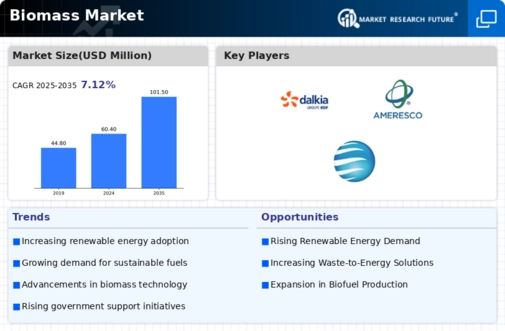-
EXECUTIVE SUMMARY
-
MARKET ATTRACTIVENESS
-
ANALYSIS
-
BIOMASS MARKET, BY FEEDSTOCK
-
BIOMASS MARKET, BY TECHNOLOGY
-
BIOMASS MARKET, BY PRODUCT
-
BIOMASS MARKET, BY END-USE
-
BIOMASS MARKET, BY
-
REGION
-
MARKET
-
INTRODUCTION
-
DEFINITION
-
SCOPE OF THE STUDY
-
RESEARCH OBJECTIVE
-
MARKET STRUCTURE
-
RESEARCH METHODOLOGY
-
RESEARCH PROCESS
-
PRIMARY RESEARCH
-
SECONDARY RESEARCH
-
MARKET SIZE ESTIMATION
-
TOP-DOWN & BOTTOM-UP APPROACH
-
FORECAST MODEL
-
LIST OF ASSUMPTIONS
-
MARKET DYNAMICS
-
OVERVIEW
-
DRIVERS
- RISING NEED TO CONTROL THE GREENHOUSE GAS EMISSIONS
-
RESTRAINTS
- COST INTENSIVE
-
SETUP WITH FEEDSTOCK AND SUPPLY CHAIN COMPLEXITIES
-
OPPORTUNITIES
- SURGING FAVORABLE REGULATIONS AND INITIATIVES
-
BY GOVERNMENT AND MAJOR MARKET PLAYERS
-
CHALLENGES
- PRESENCE OF ALTERNATIVE RENEWABLE ENERGY RESOURCES
-
MARKET FACTOR ANALYSIS
-
SUPPLY CHAIN ANALYSIS
- BIOMASS FEEDSTOCK
-
PRODUCTION
-
PRE-TREATMENT
-
ENERGY CONVERSION
-
END USERS
-
LIST OF POTENTIAL BUYERS (NAME, HEADQUARTERS, APPLICATION)
-
PORTER''S FIVE FORCES MODEL
- THREAT OF NEW ENTRANTS
- BARGAINING POWER
- INTENSITY OF RIVALRY
-
OF SUPPLIERS
-
THREAT OF SUBSTITUTES
-
BARGAINING POWER OF BUYERS
-
FEEDSTOCK PRICING OVERVIEW (USD/TON)
-
COST COMPONENTS & BREAKDOWN
-
(2021)
-
BIOMASS PRODUCTION ANALYSIS, 2019 TO 2050, (KILOTONS)
-
SUPPLY DEMAND ANALYSIS BY REGION, CURRENT &
-
DEVLOPMENT TO 2050
-
REGULATORY FRAMEWORK
-
REGULATORY FRAMEWORKS BY GOVERNMENTS
-
US
-
CANADA:
-
FRANCE:
-
GERMANY:
-
UK
-
CHINA:
-
INDIA:
-
SOUTH AFRICA:
-
UAE:
-
BRAZIL:
-
REGIONAL MARKET TRENDS
-
IMPACT OF CORONAVIRUS OUTBREAK ON THE GLOBAL
-
BIOMASS MARKET
-
GLOBAL BIOMASS MARKET, BY FEEDSTOCK
-
OVERVIEW
- BIOMASS: MARKET ESTIMATES & FORECAST BY FEEDSTOCK,
- BIOMASS: MARKET
-
BIOMASS: MARKET ESTIMATES & FORECAST BY FEEDSTOCK, 2019–2050
-
ESTIMATES & FORECAST BY FEEDSTOCK, 2019–2050
-
WOOD
-
FOOD CROP
-
NON-FOOD CROP
-
AGRICULTURAL RESIDUE
-
MUNICIPAL SOLID WASTE (MSW)
-
MICROALGAE
-
OTHERS
-
GLOBAL BIOMASS MARKET, BY TECHNOLOGY
-
OVERVIEW
- BIOMASS: MARKET
- BIOMASS: MARKET ESTIMATES & FORECAST BY
-
ESTIMATES & FORECAST BY TECHNOLOGY, 2019–2050
-
TECHNOLOGY, 2019–2050
-
CO-FIRING COMBINED HEAT AND POWER (CHP)
-
ANAEROBIC DIGESTION, AND GASIFICATION
-
CO-FIRING
-
LANDFILL GAS
-
GLOBAL BIOMASS MARKET,
-
BY PRODUCT
-
OVERVIEW
-
BIOMASS: MARKET ESTIMATES & FORECAST BY PRODUCT, 2019–2050
-
& FORECAST BY PRODUCT, 2019–2050
-
BIOMASS: MARKET ESTIMATES
-
BIODIESEL
-
BIOMETHANOL
-
BIOGAS
-
OTHERS
-
GLOBAL BIOMASS MARKET, BY END-USE
-
OVERVIEW
- BIOMASS: MARKET ESTIMATES
- BIOMASS: MARKET ESTIMATES & FORECAST BY
-
& FORECAST BY END-USE, 2019–2050
-
END-USE, 2019–2050
-
INDUSTRIAL
-
COMMERCIAL
-
RESIDENTIAL
-
GLOBAL BIOMASS MARKET, BY REGION
-
OVERVIEW
-
NORTH AMERICA
- US
- CANADA
-
EUROPE
- GERMANY
- ITALY
- FRANCE
- SPAIN
- UK
- REST OF EUROPE
-
ASIA-PACIFIC
- CHINA
- INDIA
- JAPAN
- SOUTH KOREA
- REST OF ASIA-PACIFIC
-
LATIN AMERICA
- BRAZIL
- MEXICO
- ARGENTINA
- RSET OF LATIN AMERICA
-
MIDDLE EAST & AFRICA
- GCC COUNTRIES
- SOUTH AFRICA
- EGYPT
- REST OF MIDDLE EAST & AFRICA
-
COMPETITIVE LANDSCAPE
-
MARKET INTRODUCTION
-
KEY DEVELOPMENTS
-
GLOBAL MARKET STRATEGY
-
ANALYSIS
-
COMPETITIVE BENCHMARKING
-
PRODUCTION ANALYSIS, BY KEY PLAYERS* (METRIC TONS PER ANNUM)
-
COMPANY PROFILES
-
BABCOCK & WILCOX
-
ENTERPRISES, INC
-
COMPANY OVERVIEW
-
FINANCIAL OVERVIEW
-
PRODUCT OFFERED
-
KEY DEVELOPMENTS
-
SWOT ANALYSIS
-
KEY STRATEGIES
-
DALKIA
-
COMPANY OVERVIEW
-
FINANCIAL OVERVIEW
-
PRODUCTS OFFERED
-
KEY DEVELOPMENTS
-
SWOT ANALYSIS
-
KEY STRATEGIES
-
ENVITEC BIOGAS AG
-
COMPANY OVERVIEW
-
FINANCIAL OVERVIEW
-
PRODUCTS OFFERED
-
KEY DEVELOPMENTS
-
SWOT ANALYSIS
-
KEY STRATEGIES
-
AMERESCO INC.
-
COMPANY OVERVIEW
-
FINANCIAL OVERVIEW
-
PRODUCTS OFFERED
-
KEY DEVELOPMENT
-
SWOT ANALYSIS
-
KEY STRATEGIES
-
DRAX GROUP
-
COMPANY OVERVIEW
-
FINANCIAL OVERVIEW
-
PRODUCTS OFFERED
-
KEY DEVELOPMENTS
-
SWOT ANALYSIS
-
KEY STRATEGIES
-
ORSTED A/S
-
COMPANY OVERVIEW
-
FINANCIAL OVERVIEW
-
PRODUCTS OFFERED
-
KEY DEVELOPMENTS
-
SWOT ANALYSIS
-
KEY STRATEGIES
-
MVV ENERGIE AG
-
COMPANY OVERVIEW
-
FINANCIAL OVERVIEW
-
PRODUCTS OFFERED
-
KEY DEVELOPMENTS
-
SWOT ANALYSIS
-
KEY STRATEGIES
-
MITSUBISHI HEAVY INDUSTRIES, LTD
-
COMPANY OVERVIEW
-
FINANCIAL OVERVIEW
-
PRODUCTS OFFERED
-
KEY DEVELOPMENTS
-
SWOT ANALYSIS
-
KEY STRATEGIES
-
VATTENFALL AB
- COMPANY OVERVIEW
- FINANCIAL OVERVIEW
- PRODUCTS OFFERED
- KEY DEVELOPMENTS
- SWOT ANALYSIS
- KEY STRATEGIES
-
STATKRAFT AS
- COMPANY OVERVIEW
- FINANCIAL OVERVIEW
- PRODUCTS OFFERED
- KEY DEVELOPMENTS
- SWOT ANALYSIS
- KEY STRATEGIES
-
APPENDIX
-
REFERENCES
-
RELATED REPORTS
-
-
LIST OF TABLES
-
LIST OF ASSUMPTIONS
-
LIST OF POTENTIAL BUYERS (NAME, HEADQUARTERS,
-
APPLICATION)
-
TABLE
-
GLOBAL BIOMASS PRICING OVERVIEW, (USD/TON), 2019-2021
-
GLOBAL BIOMASS MARKET, BY REGION (KILOTON),
-
TABLE
-
SUPPLY DEMAND ANALYSIS BY REGION (KILOTONS), 2021
-
SUPPLY DEMAND ANALYSIS BY REGION (KILOTONS),
-
TABLE
-
BIOMASS MARKET ESTIMATES & FORECAST, BY FEEDSTOCK, 2019–2050 (USD MILLION)
-
BIOMASS MARKET
-
ESTIMATES & FORECAST, BY FEEDSTOCK, 2019–2050 (KILOTONS)
-
BIOMASS MARKET ESTIMATES
-
& FORECAST, BY FEEDSTOCK, 2019–2050 (TERAJOULES)
-
BIOMASS MARKET ESTIMATES & FORECAST,
-
BY TECHNOLOGY, 2019–2050 (USD MILLION)
-
BIOMASS MARKET ESTIMATES & FORECAST,
-
BY TECHNOLOGY, 2019–2050 (KILOTONS)
-
BIOMASS MARKET ESTIMATES & FORECAST,
-
BY PRODUCT, 2019–2050 (USD MILLION)
-
BIOMASS MARKET ESTIMATES & FORECAST,
-
BY PRODUCT, 2019–2050 (KILOTONS)
-
BIOMASS MARKET ESTIMATES & FORECAST, BY END-USE,
-
BIOMASS MARKET ESTIMATES & FORECAST, BY END-USE, 2019–2050
-
(KILOTONS)
-
TABLE
-
GLOBAL BIOMASS MARKET, BY REGION, 2019–2050 (USD MILLION)
-
GLOBAL BIOMASS MARKET,
-
BY REGION, 2019–2050 (KILOTONS)
-
NORTH AMERICA: BIOMASS MARKET, BY COUNTRY, 2019–2050
-
(USD MILLION)
-
TABLE
-
NORTH AMERICA: BIOMASS MARKET, BY COUNTRY, 2019–2050 (KILOTONS)
-
NORTH AMERICA:
-
BIOMASS MARKET, BY FEEDSTOCK, 2019–2050 (USD MILLION)
-
NORTH AMERICA: BIOMASS MARKET, BY FEEDSTOCK,
-
NORTH AMERICA: BIOMASS MARKET, BY TECHNOLOGY, 2019–2050
-
(USD MILLION)
-
TABLE
-
NORTH AMERICA: BIOMASS MARKET, BY TECHNOLOGY, 2019–2050 (KILOTONS)
-
NORTH AMERICA:
-
BIOMASS MARKET, BY PRODUCT, 2019–2050 (USD MILLION)
-
NORTH AMERICA: BIOMASS MARKET, BY PRODUCT,
-
NORTH AMERICA: BIOMASS MARKET, BY END-USE, 2019–2050
-
(USD MILLION)
-
TABLE
-
NORTH AMERICA: BIOMASS MARKET, BY END-USE, 2019–2050 (KILOTONS)
-
US: BIOMASS
-
MARKET, BY FEEDSTOCK, 2019–2050 (USD MILLION)
-
US: BIOMASS MARKET, BY FEEDSTOCK, 2019–2050
-
(KILOTONS)
-
TABLE
-
US: BIOMASS MARKET, BY TECHNOLOGY, 2019–2050 (USD MILLION)
-
US: BIOMASS MARKET,
-
BY TECHNOLOGY, 2019–2050 (KILOTONS)
-
US: BIOMASS MARKET, BY PRODUCT, 2019–2050
-
(USD MILLION)
-
TABLE
-
US: BIOMASS MARKET, BY PRODUCT, 2019–2050 (KILOTONS)
-
US: BIOMASS MARKET,
-
BY END-USE, 2019–2050 (USD MILLION)
-
US: BIOMASS MARKET, BY END-USE, 2019–2050
-
(KILOTONS)
-
TABLE
-
CANADA: BIOMASS MARKET, BY FEEDSTOCK, 2019–2050 (USD MILLION)
-
CANADA BIOMASS
-
MARKET, BY FEEDSTOCK, 2019–2050 (KILOTONS)
-
CANADA: BIOMASS MARKET, BY TECHNOLOGY, 2019–2050
-
(USD MILLION)
-
TABLE
-
CANADA: BIOMASS MARKET, BY TECHNOLOGY, 2019–2050 (KILOTONS)
-
CANADA: BIOMASS MARKET,
-
BY PRODUCT, 2019–2050 (USD MILLION)
-
CANADA: BIOMASS MARKET, BY PRODUCT, 2019–2050
-
(KILOTONS)
-
TABLE
-
CANADA: BIOMASS MARKET, BY END-USE, 2019–2050 (USD MILLION)
-
CANADA: BIOMASS MARKET,
-
BY END-USE, 2019–2050 (KILOTONS)
-
EUROPE: BIOMASS MARKET, BY COUNTRY, 2019–2050
-
(USD MILLION)
-
TABLE
-
EUROPE: BIOMASS MARKET, BY COUNTRY, 2019–2050 (KILOTONS)
-
EUROPE: BIOMASS MARKET,
-
BY FEEDSTOCK, 2019–2050 (USD MILLION)
-
EUROPE BIOMASS MARKET, BY FEEDSTOCK, 2019–2050
-
(KILOTONS)
-
TABLE
-
EUROPE: BIOMASS MARKET, BY TECHNOLOGY, 2019–2050 (USD MILLION)
-
EUROPE: BIOMASS
-
MARKET, BY TECHNOLOGY, 2019–2050 (KILOTONS)
-
EUROPE: BIOMASS MARKET, BY PRODUCT, 2019–2050
-
(USD MILLION)
-
TABLE
-
EUROPE: BIOMASS MARKET, BY PRODUCT, 2019–2050 (KILOTONS)
-
EUROPE: BIOMASS MARKET,
-
BY END-USE, 2019–2050 (USD MILLION)
-
EUROPE: BIOMASS MARKET, BY END-USE, 2019–2050
-
(KILOTONS)
-
TABLE
-
GERMANY: BIOMASS MARKET, BY FEEDSTOCK, 2019–2050 (USD MILLION)
-
GERMANY BIOMASS
-
MARKET, BY FEEDSTOCK, 2019–2050 (KILOTONS)
-
GERMANY BIOMASS MARKET, BY TECHNOLOGY, 2019–2050
-
(USD MILLION)
-
TABLE
-
GERMANY BIOMASS MARKET, BY TECHNOLOGY, 2019–2050 (KILOTONS)
-
GERMANY BIOMASS MARKET,
-
BY PRODUCT, 2019–2050 (USD MILLION)
-
GERMANY BIOMASS MARKET, BY PRODUCT, 2019–2050
-
(KILOTONS)
-
TABLE
-
GERMANY: BIOMASS MARKET, BY END-USE, 2019–2050 (USD MILLION)
-
GERMANY: BIOMASS
-
MARKET, BY END-USE, 2019–2050 (KILOTONS)
-
ITALY: BIOMASS MARKET, BY FEEDSTOCK, 2019–2050
-
(USD MILLION)
-
TABLE
-
ITALY BIOMASS MARKET, BY FEEDSTOCK, 2019–2050 (KILOTONS)
-
ITALY BIOMASS MARKET,
-
BY TECHNOLOGY, 2019–2050 (USD MILLION)
-
ITALY BIOMASS MARKET, BY TECHNOLOGY, 2019–2050
-
(KILOTONS)
-
TABLE
-
ITALY BIOMASS MARKET, BY PRODUCT, 2019–2050 (USD MILLION)
-
ITALY BIOMASS MARKET,
-
BY PRODUCT, 2019–2050 (KILOTONS)
-
ITALY: BIOMASS MARKET, BY END-USE, 2019–2050
-
(USD MILLION)
-
TABLE
-
ITALY: BIOMASS MARKET, BY END-USE, 2019–2050 (KILOTONS)
-
FRANCE: BIOMASS MARKET,
-
BY FEEDSTOCK, 2019–2050 (USD MILLION)
-
FRANCE BIOMASS MARKET, BY FEEDSTOCK, 2019–2050
-
(KILOTONS)
-
TABLE
-
FRANCE BIOMASS MARKET, BY TECHNOLOGY, 2019–2050 (USD MILLION)
-
FRANCE BIOMASS
-
MARKET, BY TECHNOLOGY, 2019–2050 (KILOTONS)
-
FRANCE BIOMASS MARKET, BY PRODUCT, 2019–2050
-
(USD MILLION)
-
TABLE
-
FRANCE BIOMASS MARKET, BY PRODUCT, 2019–2050 (KILOTONS)
-
FRANCE: BIOMASS MARKET,
-
BY END-USE, 2019–2050 (USD MILLION)
-
FRANCE: BIOMASS MARKET, BY END-USE, 2019–2050
-
(KILOTONS)
-
TABLE
-
SPAIN: BIOMASS MARKET, BY FEEDSTOCK, 2019–2050 (USD MILLION)
-
SPAIN: BIOMASS
-
MARKET, BY FEEDSTOCK, 2019–2050 (KILOTONS)
-
SPAIN: BIOMASS MARKET, BY TECHNOLOGY, 2019–2050
-
(USD MILLION)
-
TABLE
-
SPAIN: BIOMASS MARKET, BY TECHNOLOGY, 2019–2050 (KILOTONS)
-
SPAIN: BIOMASS MARKET,
-
BY PRODUCT, 2019–2050 (USD MILLION)
-
SPAIN: BIOMASS MARKET, BY PRODUCT, 2019–2050
-
(KILOTONS)
-
TABLE
-
SPAIN: BIOMASS MARKET, BY END-USE, 2019–2050 (USD MILLION)
-
SPAIN: BIOMASS MARKET,
-
BY END-USE, 2019–2050 (KILOTONS)
-
UK: BIOMASS MARKET, BY FEEDSTOCK, 2019–2050
-
(USD MILLION)
-
TABLE
-
UK BIOMASS MARKET, BY FEEDSTOCK, 2019–2050 (KILOTONS)
-
UK BIOMASS MARKET, BY
-
TECHNOLOGY, 2019–2050 (USD MILLION)
-
UK BIOMASS MARKET, BY TECHNOLOGY, 2019–2050
-
(KILOTONS)
-
TABLE
-
UK BIOMASS MARKET, BY PRODUCT, 2019–2050 (USD MILLION)

















Leave a Comment